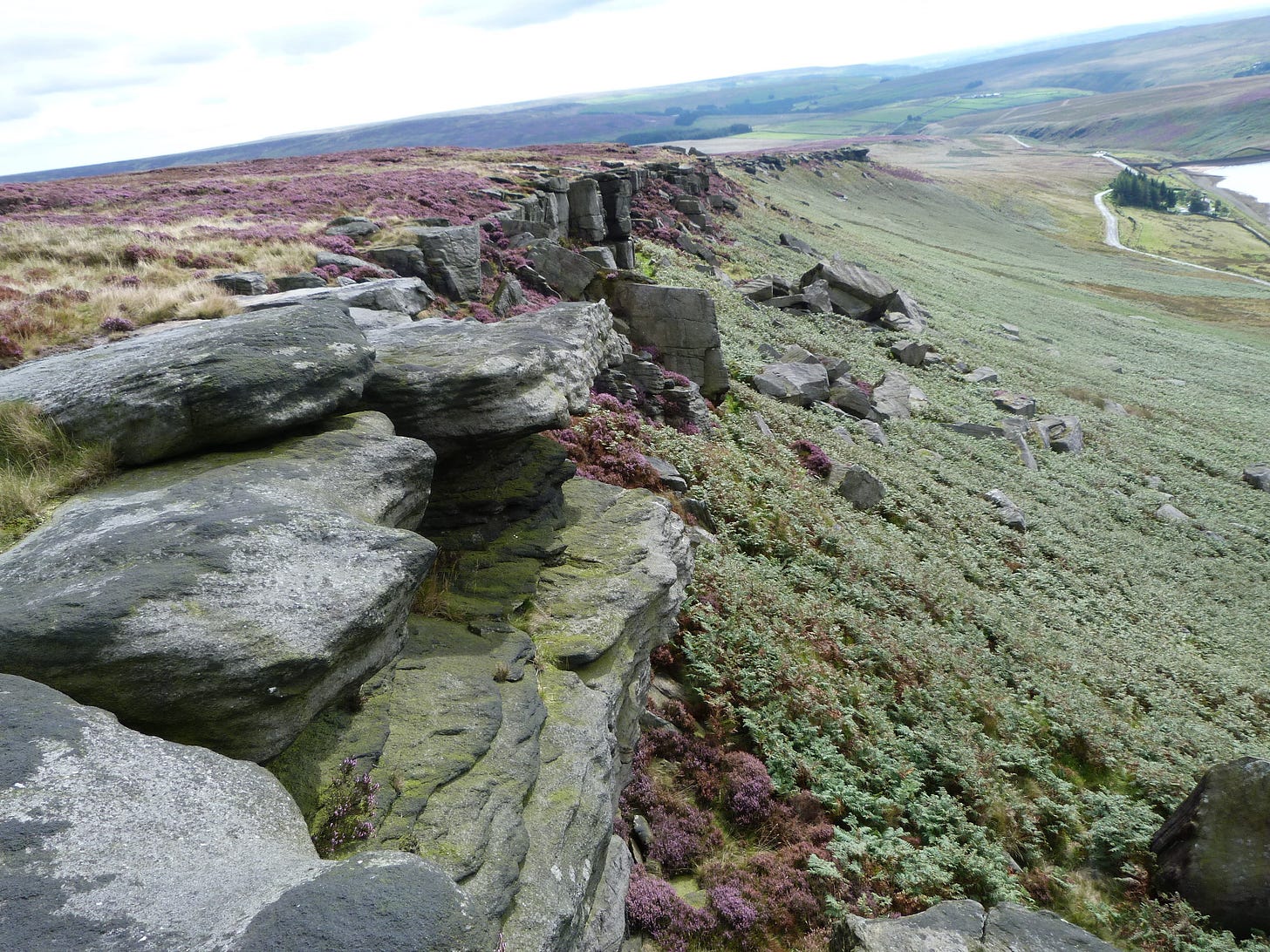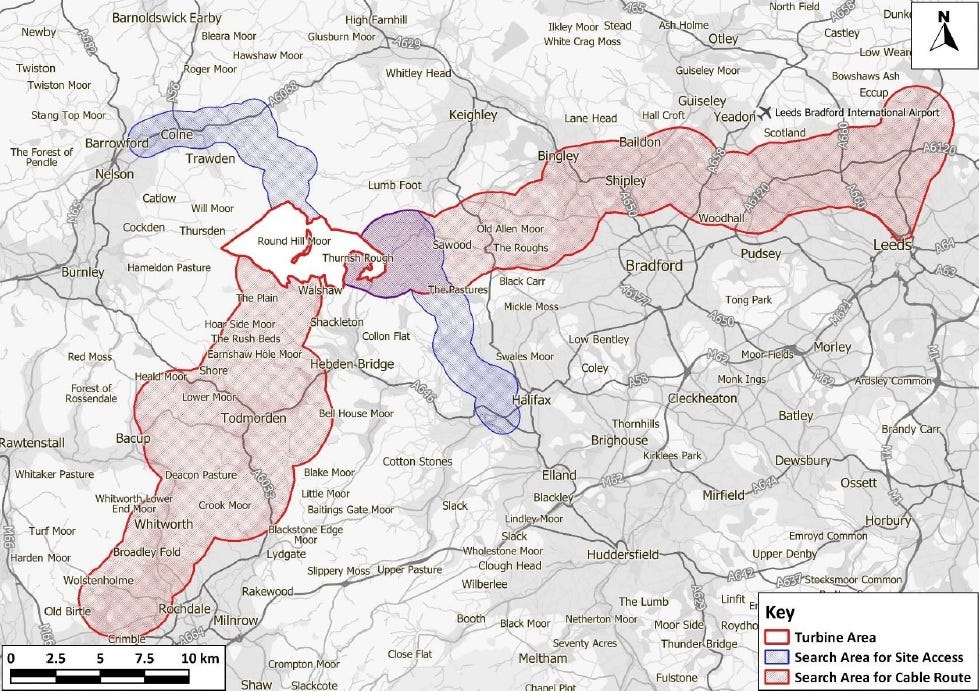Controversial wind farm could be operating by mid-2029, say developers
Plus, Shay boss rues bad decisions as Town lose on road
Hello and welcome to The Calderdale Lead!
I hope you’re all well and have had a good weekend so far.
In today’s edition, we have the latest on the controversial wind farm that is being planned for Walshaw Moor.
And we’ve got reaction from Halifax Town boss Adam Lakeland after his side’s 3-0 defeat at Southend United yesterday.
So, on with the news…
Controversial wind farm could power homes as far as Rochdale and Leeds
By John Greenwood
A controversial giant windfarm planned for moorland above Calderdale would seek grid connection points as far afield as Bradford, Leeds and Rochdale, if Government ultimately gives it the go-ahead.
Calder Wind Farm Ltd wants to install 41 of the turbines – opponents of the scheme say each would be bigger than Blackpool Tower – on 2.352 hectares or moorland at Walshaw Moor above Hebden Bridge.
Called Calderdale Energy Park, the impact would be wide-reaching, with an Environmental Impact Assessment being submitted to Government showing a search for “cable corridors” and connection points reaching further into West Yorkshire and into Greater Manchester.
The company estimates that if it is given permission, the turbines and infrastructure including some new roads would take 30 months to construct with “earliest on-site date quarter two 2029”.
It estimates being operational from 2031 for 35 years before being decommissioned.
The company argues that the Calderdale Energy Park would be capable of generating enough electricity to power the equivalent of approximately 250,000 homes, helping meet the country’s energy needs.
But opponents of the scheme are extremely concerned about potential impacts the windfarm might have on protective peatland and the moorland habitat, including nesting birds, and impacting visually, including on “Bronte country”.
Calder Wind Farm’s application seeking an order granting it development consent for Calderdale Energy Park is currently at pre-application stage.
The project falls into the Nationally Significant Infrastructure Project (NSIP) category – meaning the Government will make the final decision through the Secretary of State for Energy Security and Net Zero, currently Ed Miliband.
The applicant is asking the Planning Inspectorate, on behalf of the Secretary of State, for its written opinion as to the scope and level of detail to be provided in the Environmental Statement which is to be submitted with the application.
Although Calderdale Council will not determine the application – the Governement will – senior councillors have said the authority will still have a role to play, as a consultee at several stages.
This includes it being one of the bodies which must be consulted on the Environmental Statement, with its responses having to be received by the Planning Inspectorate by September 29, 2025.
The letter from the Planning Inspectorate informing the council of its consultee status, and a copy of a 577-page Environmental Impact Statement (EIA) the company has published, can be viewed on the council’s Planning Portal, number 25/06014/EIA.
The document shows as yet unidentified “points of connection” to the grid will need to be sought “routed to avoid properties”, with “cable corridors” likely to be in the Rochdale area to the west and Bradford West to the east, with connection from there to a new substation at Leeds North also proposed.
It also indicates the project would require a Battery Energy Storage System (BESS) compound and require a substation, both at locations yet to be identified, according to the EIA.
The EIA says policy guidance being taken into account includes national policy, Calderdale and Rossendale Local Plans, the Rochdale Core Strategy, Bradford Council’s Core Strategy Development Plan and Leeds City Council Core Strategy.
Issues which are being taken into consideration include non-statutory and statutory consultation, cumulative effects of the windfarm, methodology, technical details and data and a Habitats Regulations Assessment.
These will include impacts on biodiversity, ornithology, hydrology, hydro-geology, geology, peat, cultural heritage, landscape and visual settings, access, traffic and transport, carbon and climate change, noise and vibration, air quality, human health, socio-economics, land use, tourism and recreation, aviation and radar and other matters, including shadow flicker, and how these impacts might be managed, according to the EIA.
Recently the council’s Deputy Leader, Coun Scott Patient said the council was a statutory consultee throughout the process.
“The council’s role is to ensure that the developer addresses local impacts and issues very early in the process.
“It (the council) will advise on local planning policies and highlight impacts on key local issues such as the green belt, ecology, highways, landscape, and flood risk,” he told a meeting of the full Calderdale Council.
‘Second best’: Halifax boss Lakeland rues poor decision-making
By Andrew Greaves
Halifax Town boss Adam Lakeland admitted his side were second best after falling to a 3-0 defeat at Southend.
The Shrimpers went in front just after the half-hour mark, Andy Dallas heading in a cross from Gus Scott-Morriss for his third goal of the season.
Lakeland’s side did rally in the second half but the task was made hard when defender Adam Alimi-Adetoro was sent off for picking up a second booking with 20 minutes left.
Southend made sure of the points through late headers from Scott-Morriss and defender Ben Goodliffe to secure a fifth league win.
And Lakeland said: "We were second best. I’m disappointed with how the scoreline got in the end, but they were better than us, certainly in that first-half.
"You're coming to one of the biggest clubs and hardest places to come in the division, it's hard enough with 11 men but as soon as you go down to ten, it's tough."
"We kept going, we tried to be positive, even when we went down to ten men, and 1-0 down."
"(I’m) just really disappointed with the second, and probably more so, the third goals, just poor goals, all three, from crosses."
Lakeland felt his players had stopped doing the basics in a first half in which Southend probably should have been further ahead.
"Our quality was off, we didn't retain the ball anywhere near well enough," he said
"We didn't try and play anywhere near enough... we didn't get the balance right and we didn't play anywhere near as much as we had to."
"That led to them having a few opportunities on transitions, which is also something we'd spoken about and we knew they were good at."
That’s it for this edition. If you want to get in touch with any story tips then just hit the button below.
Enjoy the rest of your weekend and we’ll see you on Wednesday!
Andrew




